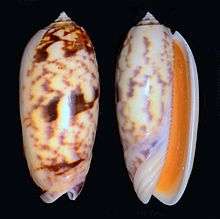Miniaceoliva miniacea
Miniaceoliva miniacea, common name the Pacific common olive, is a species of sea snail, a marine gastropod mollusk in the family Olividae, the olives.[1]
| Miniaceoliva miniacea | |
|---|---|
 | |
| Scientific classification | |
| Kingdom: | |
| Phylum: | |
| Class: | |
| (unranked): | |
| Superfamily: | |
| Family: | |
| Genus: | Miniaceoliva |
| Species: | M. miniacea |
| Binomial name | |
| Miniaceoliva miniacea (Röding, 1798) | |
| Synonyms | |
| |
There are two subspecies:
- Oliva miniacea berti Terzer, 1986: synonym of Miniaceoliva efasciata berti (Terzer, 1986)
- Oliva miniacea tremulina Lamarck, 1811: synonym of Miniaceoliva tremulina (Lamarck, 1811)
Description
The length of the shell varies between 45 mm and 100mm. It is one of the larger olive snails.
As is typical of olivids, the shell of this species is smooth, glossy, and elongated, with a very long aperture. The spire of this species is quite low even for an olivid. The filament channel, a groove present on the spire of olivids, is especially distinct in this species.
Shells of this species tend to have a yellowish or pale orange ground color with a pattern of two or three wide, rough bands of a much darker color (usually dark brown or black). Finer patterning is often present between the bands. Exceedingly pale specimens may be off-white with light brown patterns. At the opposite extreme, sometimes the pattern can cover so much of the shell that the shell is nearly black. The inside of the aperture is orange or yellowish-orange.
This species has caused food poisoning with a paralytic toxin in Taiwan in 2002.[2]
_from_Okinawa.jpg)
Distribution
This species occurs in the Indian Ocean off Chagos, the Mascarene Basin and Mauritius; in the Western Pacific Ocean and in the Andaman Sea.
References
- Oliva miniacea (Röding, 1798). Retrieved through: World Register of Marine Species on 16 November 2012.
- Hwang, P. A., Tsai E. H., Lu Y. H., & Hwang D. F. (2003). Paralytic toxins in three new gastropod (Olividae) species implicated in food poisoning in southern Taiwan.
- Dautzenberg, Ph. (1929). Mollusques testacés marins de Madagascar. Faune des Colonies Francaises, Tome III
- Sargent D.M. & Petuch E.J. (2012) A new species of Oliva (Gastropoda: Olividae) from Mauritius, Mascarene Islands. Visaya 3(5): 4–10.
- Petuch, E. J.; Myers, R. F. (2014). New species and subspecies of olive shells (Gastropoda: Olividae) from the Panamic and Indo-Pacific regions and the Gulf of Mexico. The Festivus. 46(3): 63–74
External links
- "Oliva (Miniaceoliva) miniacea". Gastropods.com. Retrieved 16 January 2019.
- Oliva miniacea miniacea (Röding, 1798)
| Wikimedia Commons has media related to Miniaceoliva miniacea. |